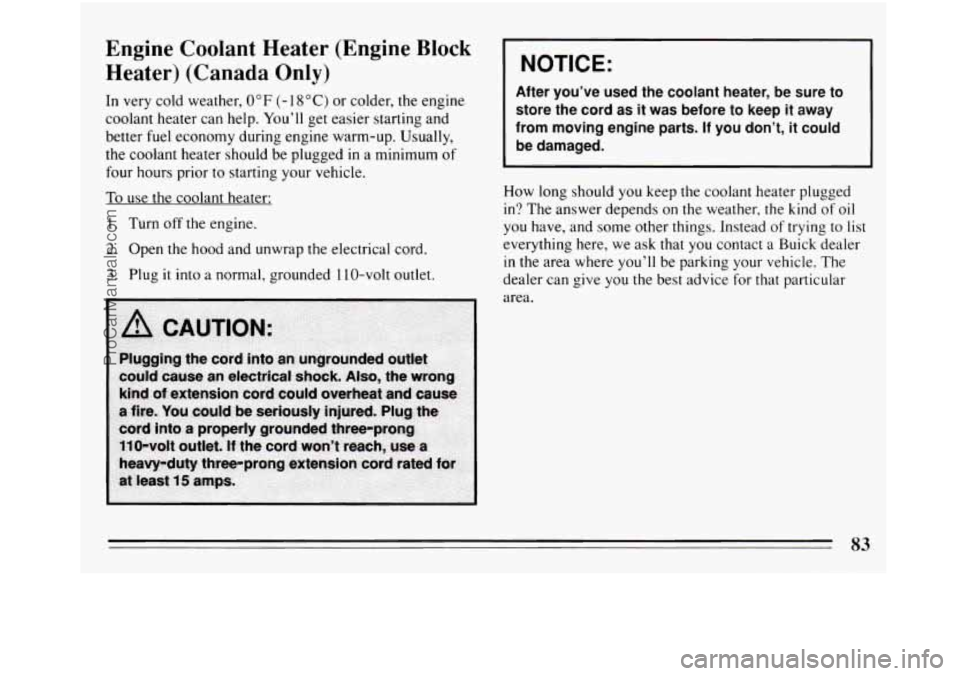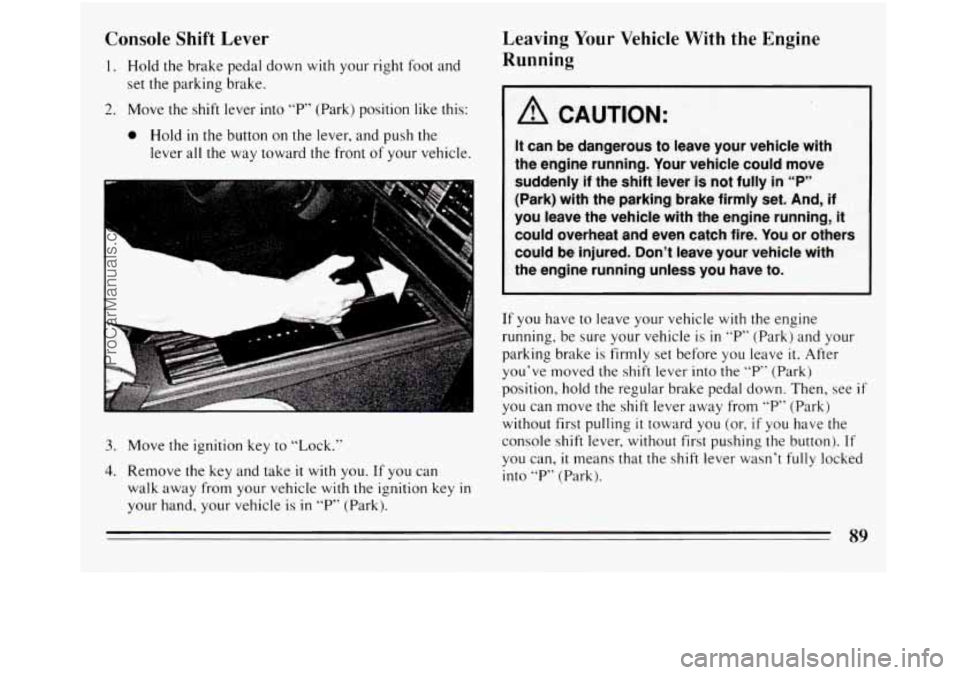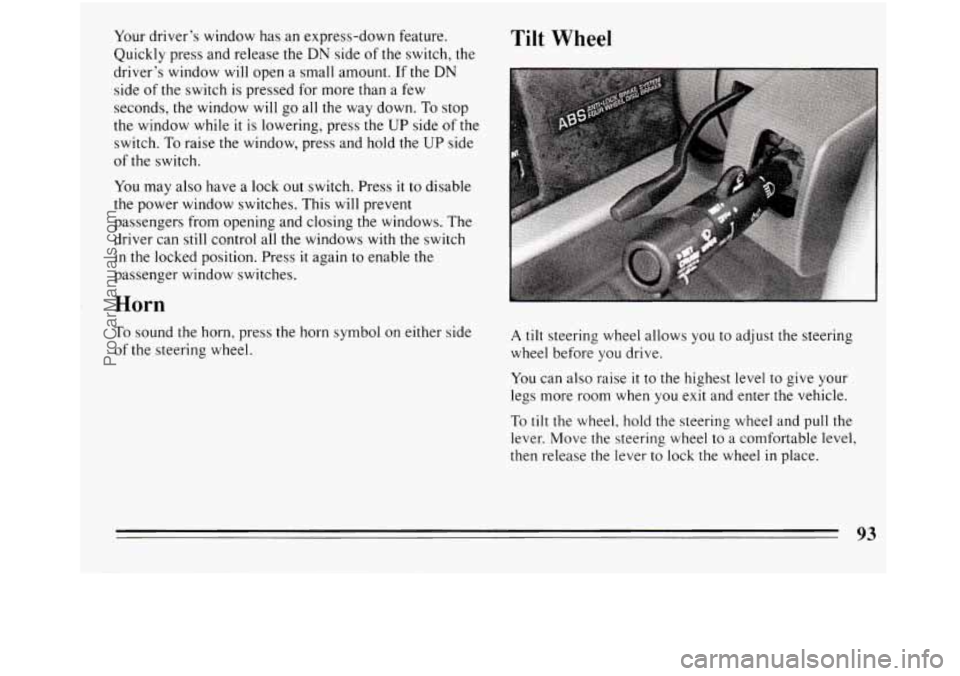Page 85 of 308

Engine Coolant Heater (Engine Block
Heater) (Canada Only)
In very cold weather, 0 "F (- 18 "C) or colder, the engine
coolant heater can help. You'll get easier starting and
better fuel economy during engine warm-up. Usually,
the coolant heater should be plugged
in a minimum of
four hours prior
to starting your vehicle.
To use the coolant heater:
1. Turn off the engine.
2. Open the hood and unwrap the electrical cord.
3. Plug it into a normal, grounded 110-volt outlet.
I NOTICE:
After you've used the coolant heater, be sure to
store the cord as it was before
to keep it away
from moving engine parts. If you don't, it could
be damaged.
How long should you keep the coolant heater plugged
in? The answer depends on
the weather, the kind of oil
you have, and some other things. Instead of trying
to list
everything here, we ask that you contact
a Buick dealer
in the area where you'll be parking your vehicle. The
dealer can give you the best advice for that particular
area.
83
ProCarManuals.com
Page 89 of 308
Parking Brake
To set the parking brake:
Hold the regular brake
pedal
down with your right
foot. Push down
the
paiking brake pedal with yourleft foot.
If the
ignition is on, the brake
system warning light will
come on.
The parking brake uses the brakes on the rear wheels.
To release the parking brake:
This vehicle has a push to release park brake pedal.
Hold
the regular brake pedal down and push the parking
brake pedal with your left foot. This will unlock the
pedal. When you lift your left foot, the park brake pedal
will follow it to the released position.
I NOTICE: 1
Driving with the parking brake on can cause your
rear brakes to overheat. You may have to replace
them, and you could also damage other parts of
your vehicle.
If you are towing a trailer and are parking on any
hill:
See “ Towing a Trailer” in the Index. That section
shows what to do first to keep the trailer from moving.
87
ProCarManuals.com
Page 90 of 308
Steering Column Shift Lever
1. Hold the brake pedal down with your right foot and
set the parking brake.
2. Move the shift lever into “P” (Park) position like
this:
0 Pull the lever toward you.
0 Move the lever up as far as it will go.
3. Move the ignition key to “Lock.”
4. Remove the key and take it with you. If you can
walk away from your vehicle with the ignition key
in
your hand, your vehicle is in “P” (Park).
88
ProCarManuals.com
Page 91 of 308

Console Shift Lever
set the parking brake.
1. Hold the brake pedal down with your right foot and
2. Move the shift lever into “P” (Park) position like this:
0 Hold in the button on the lever, and push the
lever all the way toward the front of your vehicle.
U
3. Move the ignition key to “Lock.”
4. Remove the key and take it with you. If you can
walk away from your vehicle
with the ignition key in
your hand, your vehicle is in “P” (Park).
Leaving Your Vehicle With the Engine
Running
1 A CAUTION:
If you have to leave your vehicle with the engine
running, be sure your vehicle
is in “P” (Park) and your
parking brake is firmly set before you leave
it. After
you’ve moved the shift lever into the
“P” (Park)
position, hold the regular brake pedal down. Then, see
if
you can move the shift lever away from “P” (Park)
without first pulling
it toward you (or, if you have the
console shift lever, without first pushing the button).
If
you can, it means that the shift lever wasn’t fully locked
into
“P” (Park).
89
ProCarManuals.com
Page 92 of 308
Torque Lock
If you are parking on a hill and you don’t shift your
transaxle
into “P” (Park) properly, the weight of the
vehicle may put too much force on the parking pawl in
the transaxle. You may find it difficult to pull the shift
lever out
of “P’ (Park). This is calied “torque lock.” To
prevent torque lock, set the parking brake and then shift
into
“P” (Park) properly before you leave the driver’s
seat.
To find out how, see “Shifting Into ‘P’ (Park)” in
the Index.
When you are ready to drive, move the
shift lever out of
“P’ (Park) BEFORE you release the parking brake.
If “torque lock” does occur, you may need to have
another vehicle push yours
a little uphill to take some of
the pressure from the transaxle,
so you can pull the shift
lever out
of “P’ (Park).
Parking Over Things That Burn
90
ProCarManuals.com
Page 95 of 308

Your driver’s window has an express-down feature.
Quickly press and release the DN side of the switch, the
driver’s window will open a small amount. If the DN
side
of the switch is pressed for more than a few
seconds, the window will go all the way down. To stop
the window while it is lowering, press the UP side of the
switch. To raise the window, press and hold the UP side
of
the switch.
You may also have a lock out switch. Press
it to disable
the power window switches. This will prevent
passengers from opening and closing
the windows. The
driver can still control all the windows with the switch
in the locked position. Press it again to enable the
passenger window switches.
Horn
To sound the horn, press the horn symbol on either side
of the steering wheel.
Tilt Wheel
A tilt steering wheel allows you to adjust the steering
wheel before you drive.
You can also raise
it to the highest level to give your
legs more room when you exit and enter the vehicle.
To tilt the wheel, hold the steering wheel and pull the
lever. Move the steering wheel to a comfortable level,
then release the lever
to lock the wheel in place.
ProCarManuals.com
Page 99 of 308

For a single wiping cycle, turn the band to “MIST.”
Hold
it there until the wipers start, then let go. The
wipers
will stop after one cycle. If you want more
cycles, hold the band on “MIST” longer.
You can set the wiper speed for a long or short delay
between wipes. This can be very useful
in light rain or
snow. Turn the band to choose the delay time. The
closer to
“LO,” the shorter the delay.
For steady wiping at low speed, turn the band away
from you to the
“LO” position. For high speed wiping,
turn the band further, to “HI.” To stop the wipers, move
the band to “OFF.”
Remember that damaged wiper blades may prevent you
from seeing well enough to drive safely. To avoid
damage, be sure to clear ice and snow from the wiper
blades before using them. If they‘re frozen to the
windshield, carefully loosen or thaw them. If your
blades do become damaged, get new blades or blade
inserts.
Heavy snow or ice can overload your wiper motor.
A
circuit breaker will stop the motor until it cools. Clear
away snow or ice to prevent an overload.
Windshield Washer
At the top of the turn signal/headlight beam lever there’s
a paddle
with the word “PUSH” on it. To spray washer
fluid on the windshield, push the paddle. Unless they are
already turned on, the wipers will operate at low speed
for several sweeps, then
turn off.
Driving without washer fluid can be dangerous.
A bad
mud splash can block your vision. You could
hit another
vehicle or
go off the road. Check your washer fluid level
often.
A CAUTION:
In freezing weather, don’t use your washer until
the windshield
is warmed. Otherwise the washer
fluid can form ice on the windshield, blocking
your vision.
97
ProCarManuals.com
Page 106 of 308
Your DRL work with a light sensor on top of the
instrument panel. Don’t cover it up.
The low beam headlights will come on at reduced
brightness in daylight
when:
0 The ignition is on,
0 The headlight switch is off, and
0 The parking brake is released.
At dusk, the exterior lights will come on automatically
and the low beams will change
to full brightness. At
dawn, the exterior lights will
go out and the low beams
will change to
the reduced brightness of DRL (if the
headlight switch is off).
Of course, you may still turp on the headlights any time
you need to.
To idle your vehicle with
the DRL off, set the parking
brake while the ignition
is in the “Off” or “Lock”
position. Then start the vehicle. The DRL will stay off
until
you release the parking brake.
Front Seat Reading Lights (Option)
The front seat reading lights are turned on by pressing
the switches.
104
ProCarManuals.com